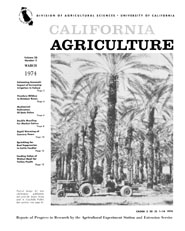|
|||
|
|||

Cover:
Typical design lor new combination pollination and pesticide duster being used in Coachella Valley date gardens.
March 1974
Volume 28, Number 3 News and opinion |
|||
|
University of California, 1301 S. 46th St., Bldg. 478 Richmond, CA
|